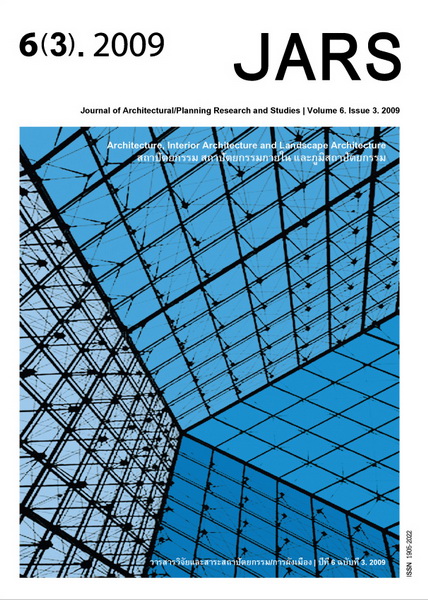In Search of Sustainable Paradigms for Conservation and Development Based on Underlying Convergent / Divergent Conceptions
Main Article Content
Abstract
Transitional societies are emerging amid continuous cultural transformations. To search for sustainable
paradigms, it is essential to clarify the various interfaces of the conservation and development dimensions,
particularly as the outcome of thinking approaches -- convergent and divergent conceptions. Convergence
induces traditional practices, while divergence leads to non-conventional outputs. In this exploratory research,
two paradigms of interrelationships regarding sustainable conservation and development are investigated:
1) in conflict; 2) in balanced integration and transformation. In order to demonstrate the conservation and
development experiences, a quadrangular conceptual framework is set along a bipolar continuum with conservation
and development dichotomy in coordination with convergence and divergence. Two specific topics, each with
examples of East / West phenomena and related perspectives, are demonstrated: 1) contemporary architecture
with uniqueness; 2) treatment approaches of cultural heritage. This study reveals certain distinctive patterns of
interrelationship between conservation and development in accordance with the considerations of convergent
and divergent conceptions. The research output, based on balanced integration between conservation and
development as sustainable paradigm, would be the basis for setting up national policy and related legislative
amendments regarding sustainable cultural conservation and development.
Downloads
Article Details

This work is licensed under a Creative Commons Attribution-NonCommercial-NoDerivatives 4.0 International License.
All material is licensed under the terms of the Creative Commons Attribution 4.0 International (CC-BY-NC-ND 4.0) License, unless otherwise stated. As such, authors are free to share, copy, and redistribute the material in any medium or format. The authors must give appropriate credit, provide a link to the license, and indicate if changes were made. The authors may do so in any reasonable manner, but not in any way that suggests the licensor endorses you or your use. The authors may not use the material for commercial purposes. If the authors remix, transform, or build upon the material, they may not distribute the modified material, unless permission is obtained from JARS. Final, accepted versions of the paper may be posted on third party repositories, provided appropriate acknowledgement to the original source is clearly noted.
References
Ampaiphan, T. (2007). Design guideline for cultural learning center in historical area (Thonburi): Adaptive re-use old architecture and infill design. Journal of Architectural / Planning Research and Studies, 5(3), 51-67.
Anderson, R. (2002). The Great Court and the British Museum. London: The British Museum Press.
Chapagain, N. K. (2009). The question of authenticity in heritage conservation and tourism. Proceedings of the 2nd Asian Academy for Heritage Management Conference 2009. Macao SAR, China: Institute for Tourism Studies, pp. 69-77.
Feilden, B. M., & Jokilehto, J. (1998). Management guidelines for world cultural heritage sites. Rome: ICCROM.
Fine Arts Department. (1985). Regulation for conservation of monuments and sites. (n.p.).
Gore, Al. (1992). Earth in balance: Ecology and the human spirit. New York: Houghton Muffin.
Horayangkura, V. (2001). The architecture of Thailand: Change amid continuity: The new challenge. In J. Lim
(Ed.), Transforming traditions: Architecture in the ASEAN countries (pp. 237, 246). Singapore: ASEAN Studies Publication Series, Unique Press.
Horayangkura, V. (2005). The future of cultural heritage conservation amid urbanization in Asia: Constraints and prospects. Journal of Architectural Research and Studies, 3, 78.
Jones, G. (2007, March 5). Saving grace. Time, pp. 46-47.
Kaner, S., Lind, L., Toldi, C., Fisk, S., & Berger, D. (2007). Facilitator’s guide to participatory decisionmaking (2nd ed.). San Francisco: John Wiley & Sons.
Knauer, K. (Ed.). (2004). Great buildings of the world by the editors of Time. New York: Time Books.
Lawson, B. (1980). How designers think. Westfield, New Jersey: Eastview Editions.
Logan, W. S. (Ed.). (2002). The disappearing ‘Asian’ city: Protecting Asia’s urban heritage in a globalizing world. Hong Kong: Oxford University Press (China).
Maso, A. D. (2006). Chinese policies cultural heritage preservation: A way to understand the peculiar approach to conservation in China. Research Conference Proceedings on Asian Approach to Conservation 2006. Bangkok, Thailand: Faculty of Architecture, Chulalongkorn University, p. 46.
Meador, K. S. (1997). Creative thinking and problem solving for young learners. Englewood, Colorado: Teacher Ideas Press.
Michael, W. (2004). The ancient quarter of Hanoi -- A reflection of urban transition processes. ASIEN, 92(July), 30-48.
Noobanjong, K. (2007). The Democracy Monument: Ideology, identity, and power manifested in built forms. Journal of Architectural / Planning Research and Studies, 5(3), 29-49.
Ping, K. (2009). ‘Social quality’ and conservation in the urban context. Proceedings of the 2nd Asian Academy for Heritage Management Conference 2009. Macao SAR, China: Institute for Tourism Studies, pp. 173 -179.
Rawlinson, J. G. (1988). Creative thinking and brainstorming. England: Wildwood House.
Saunders, W. S. (Ed.). (2005). Commodification and spectacle in architecturpe. Minneapolis: University of Minnesota Press.
Silapacharanan, S. (2006). Amphawa: Balance between cultural conservation and development. Research Conference Proceedings on Asian Approach to Conservation 2006. Bangkok, Thailand: Faculty of Architecture, Chulalongkorn University, pp. 221-226.
Wan, P. Y. K., Pinheiro, V. F., & Wu, Y. (2009). Adaptive re-use and authenticity of Mandarin Mansion Rehabilitation: Authenticity criteria and the difficult choice between a tourist-oriented facility and a local community centre. Proceedings of the 2nd Asian Academy for Heritage


